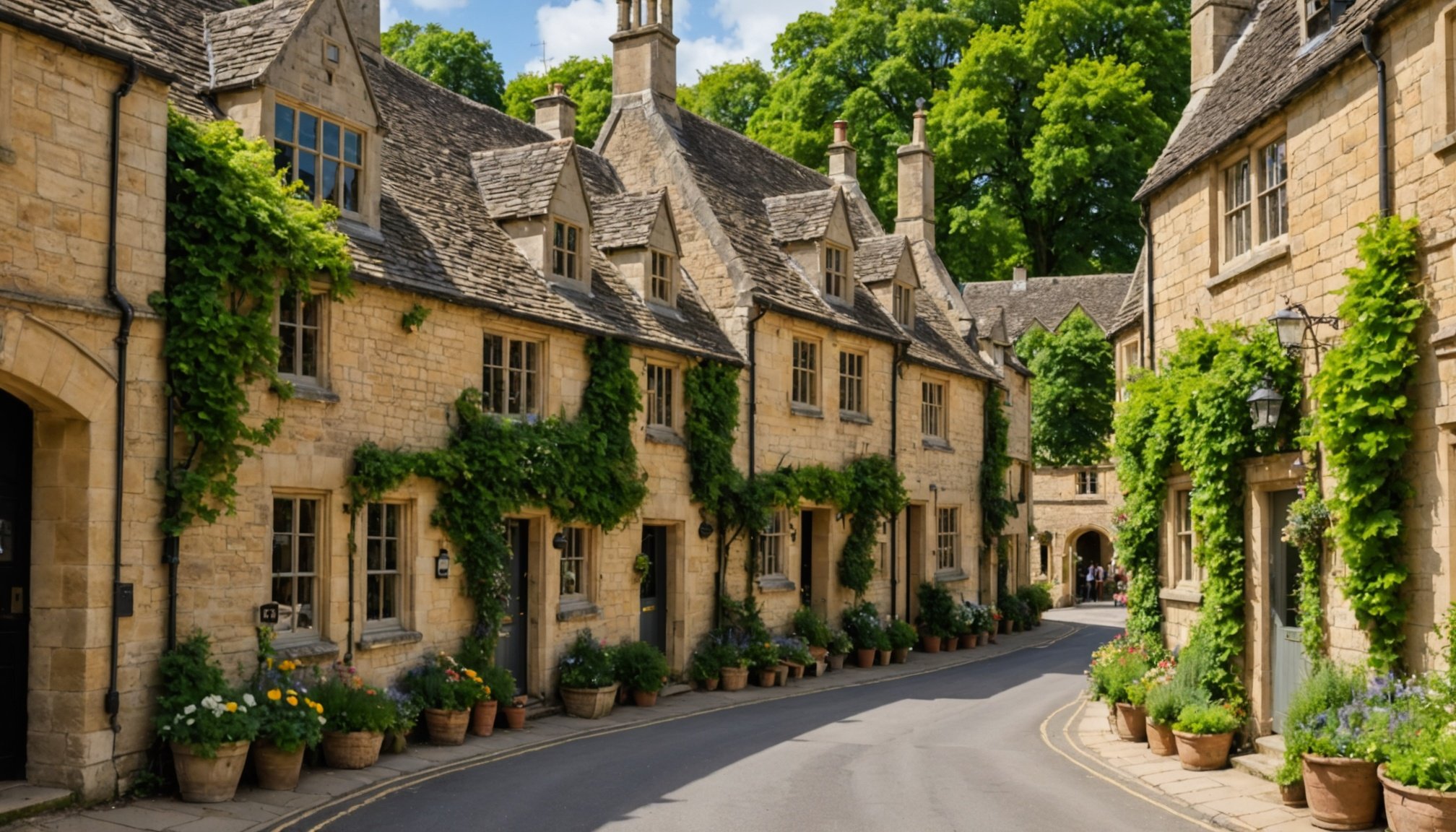Overview of the Cotswolds Walking Tours
The Cotswolds region offers a quintessential English countryside experience with its rolling hills, picturesque villages, and rich history. Serving as a walker’s paradise, the area boasts a variety of walking tours that make the most of its scenic beauty and cultural heritage. These tours are ideal for both seasoned hikers and leisurely strollers. They provide a structured yet flexible way to explore the Cotswolds at your own pace.
A key feature of these tours are the historic market towns like Bourton-on-the-Water and Stow-on-the-Wold. These towns are steeped in history and provide a charming backdrop to your walking journey. Strolling through these towns, you can immerse yourself in centuries of local history while enjoying delightful architecture and local cuisine.
Also to see : Discovering the tower of london: key insights for unveiling its rich historical legacy
Walking tours greatly enhance your Cotswold experience by offering guided routes that highlight hidden gems and popular attractions. Each path has its unique features, showcasing the best views and local culture. Whether you’re interested in nature, history, or simply the joy of walking, Cotswolds walking tours offer something special. They not only facilitate exploration but also enrich your understanding of this historic and beautiful region.
Key Walking Routes in the Cotswolds
Cotswolds walking tours offer a rich array of paths, each with its own charming landscapes and varied terrain. One popular route is the Cotswold Way, stretching over 100 miles from Chipping Campden to Bath. This trail provides breathtaking views of the English countryside, with certain sections suitable for leisurely walks while others demand a more robust hiking effort. The well-marked paths ensure even first-timers can navigate easily.
In parallel : Discover unforgettable things to do in riquewihr
For those seeking shorter excursions, the South Cotswolds Walk offers a gentle yet picturesque experience. Unlike the more demanding trails, this route allows exploration of charming villages and idyllic landscapes. Offering an average walking time of three to four hours, it serves as a perfect day-out option.
Another engaging choice is the Oxford to Stratford Trail, which blends countryside charm with the allure of historic towns. This path highlights scenic beauty while providing opportunities to visit notable landmarks. Navigating this trail can take up to two days, accommodating a moderate walking level.
To enhance your experience on these Cotswolds paths, always carry a map or a guidebook and ensure you’re prepared for various weather conditions. This foresight ensures a safe and enjoyable journey across these scenic trails.
Highlighting Historic Market Towns
Bask in the charm of the Cotswolds’ historic market towns, each offering a unique slice of history and culture. Begin in Bourton-on-the-Water, often referred to as the “Venice of the Cotswolds” due to its picturesque bridges spanning the River Windrush. The Cotswolds Motor Museum here is a delightful nod to vintage automobiles and memorabilia.
Venture to Stow-on-the-Wold, a town famed for its role in the English Civil War. Its medieval market square is surrounded by charming inns that once catered to weary traders. Today, it offers an immersive cultural experience with quaint tea rooms and delightful artisan shops.
Move on to Chipping Campden, noted for its elegant High Street, showcasing a stunning array of historic buildings. The town is rich in craftsmanship, with the Court Barn Museum celebrating local arts and crafts. A visit to Chipping Campden offers insights into the region’s artistic heritage.
These Cotswolds experiences amplify the allure of walking tours. They seamlessly blend striking architecture, intriguing histories, and vibrant local culture. Each town’s distinct highlights contribute to a richer exploration of the region’s past and present, ensuring memorable visits on every stroll.
Planning Your Walking Tour
Planning a Cotswolds walking tour requires thoughtful consideration of the essentials, ensuring a seamless adventure through this picturesque region. To make the most of your visit, it’s beneficial to time your tour during late spring or early autumn. These months showcase the countryside in vibrant hues, offering pleasant weather for exploration.
Creating a flexible itinerary is crucial for maximizing your experience. Begin by selecting a variety of walking routes that cater to your interests, be it scenic trails or historic market towns. Incorporating a diverse range of paths will enhance your appreciation of the region’s varied landscapes and cultural wealth.
Choosing the right accommodation is equally important for a satisfying trip. The Cotswolds offer a myriad of options ranging from quaint bed and breakfasts to upscale hotels. Ensure you book well in advance, particularly if you plan to visit during peak periods.
While exploring the charming towns and trails, indulge in the local cuisine to enrich your journey further. Known for its delightful fare, the region boasts traditional English pubs and artisanal eateries that are perfect for unwinding after a day of walking. Be sure to pencil in time for these culinary experiences to truly savor the essence of the Cotswolds.
Local Attractions and Activities
Unlock a treasure trove of local attractions and vibrant cultural activities while traversing the captivating Cotswolds. Whether you’re exploring historic sites, embracing natural wonders, or delving into the region’s artisan crafts, your journey is poised to be delightful.
Historical Sites
Enhance your walk with visits to key historical sites like Sudeley Castle or the ancient Roman villa near Chedworth. Each site offers a glimpse into the region’s storied past, with tours that breathe life into centuries-old tales. As you wander, marvel at the lasting architecture and uncover the narratives that shaped these iconic locales.
Natural Attractions
Immerse yourself in the stunning natural attractions, such as the majestic Cotswold Wildlife Park. Meander through the natural parks and reserves that dot the landscape, offering diverse flora and fauna. These areas are perfect for leisurely strolls or invigorating hikes, allowing you to bask in the serenity of the countryside.
Craft and Artisanship
Engage with local heritage by visiting artisan workshops renowned for their crafts. The region’s artisans excel in producing pottery, textiles, and more. Observing skilled craftsmen in action provides insights into the craft and artisanship that define Cotswolds culture. For travellers, these interactions offer a tactile connection to the region’s creative spirit.
Practical Travel Advice
Embarking on Cotswolds walking tours requires careful planning to ensure a seamless experience. To reach this picturesque destination, consider a range of transportation options. These include regional buses and trains, which connect major cities like London and Oxford to nearby towns such as Moreton-in-Marsh and Cheltenham. Rental cars are ideal for greater flexibility, allowing easy access to the historic market towns peppered across the landscape.
Walking through rural areas demands adherence to essential safety tips. Always carry a charged mobile phone and inform someone of your planned route. Wearing weather-appropriate clothing and sturdy footwear will enhance comfort on varied terrain. Use maps or local travel guides to navigate with confidence, especially in remote areas where GPS signals might falter.
To make the most of your experience, leverage local resources. Many walking tours offer qualified guides who provide valuable insights into the area’s history, culture, and geography. Engaging with these experts can elevate your appreciation of the Cotswolds’ unique charm. Furthermore, consult community forums or tourism websites to stay informed about seasonal events and attractions that may align with your journey.











